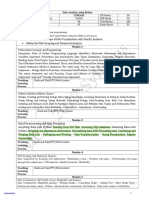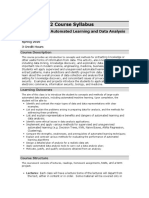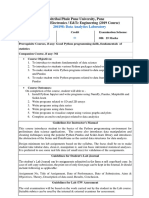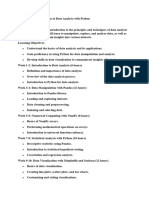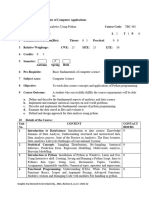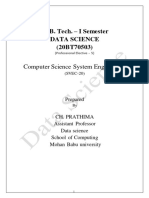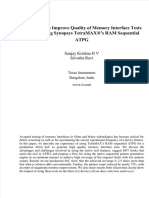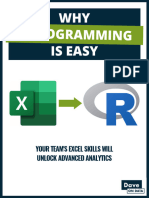Annexure-II 1
EXPLORATORY DATA ANALYSIS Semester 6
Course Code BDS613B CIE Marks 50
Teaching Hours/Week (L: T:P: S) 3:0:0:0 SEE Marks 50
Total Hours of Pedagogy 40 Total Marks 100
Credits 03 Exam Hours 3
Examination type (SEE) Theory
Course objectives:
CLO1: To equip students with Python, IPython, and Jupyter for data analysis tasks.
CLO2: To provide a comprehensive understanding of NumPy for scientific computations.
CLO3: To introduce foundational and advanced data manipulation techniques using Pandas
CLO4: To enhance data visualization skills using Matplotlib and Seaborn
CLO5: To introduce Machine Learning concept with practical applications using Scikit-Learn.
CLO6: To promote the practical application of data analysis tools and techniques on real-world
datasets
Teaching-Learning Process (General Instructions)
These are sample Strategies, which teachers can use to accelerate the attainment of the various
course outcomes.
1. Lecturer method (L) needs not to be only a traditional lecture method, but alternative
effective teaching methods could be adopted to attain the outcomes.
2. Use of Video/Animation/Demonstration to explain functioning of various concepts.
3. Encourage collaborative (Group Learning) Learning in the class.
4. Ask at least three HOT (Higher order Thinking) questions in the class, which promotes
critical thinking.
5. Adopt Problem Based Learning (PBL), which fosters students’ Analytical skills, develop
design thinking skills such as the ability to design, evaluate, generalize, and analyze
information rather than simply recall it.
6. Use animations/videos to help the students to understand the concepts.
7. Demonstrate the concepts using PYTHON and its libraries
Module-1
Introduction to Python and NumPy: Getting Started in IPython and Jupyter, Enhanced Interactive
Features, The Basics of NumPy Arrays, Sorted Arrays, Structured Data: NumPy’s Structured Arrays
Textbook: Chapter 2, Chapter 5, Chapter 11, Chapter 12, Chapter 1(Not for CIE/SEE),
Module-2
Data Manipulation with Pandas - I: Introducing Pandas Objects, Handling Missing Data, Hierarchical
Indexing, Pivot Tables.
Textbook: Chapter 13, Chapter 16, Chapter 17, Chapter 21
Module-3
Data Manipulation with Pandas - II: Vectorized String Operations, Working with Time Series, High-
Performance Pandas: eval and query
Textbook: Chapter 22, Chapter 23, Chapter 24
Module-4
@#@10012025 1
� Annexure-II 2
Data Visualization with MatPlotlib: General Matplotlib Tips, Simple Line Plots, Simple Scatter Plots,
Visualization with Seaborn
Textbook: Chapter 25, Chapter 26, Chapter 27, Chapter 36
Module-5
Introduction to Machine Learning: Machine Learning, Introducing Scikit-Learn, Hyperparameters and
Model Validation.
Textbook: Chapter 37, Chapter 38, Chapter 39
Course outcome (Course Skill Set)
At the end of the course, the student will be able to :
1. Demonstrate the application of the NumPy for performing data analysis tasks.
2. Make use of Pandas for various data manipulation tasks.
3. Apply advanced data manipulation techniques to real-world datasets.
4. Develop data visualizations using Matplotlib and Seaborn to effectively communicate data insights.
5. Explain the fundamental concepts of machine learning and validation models using Scikit-Learn.
Assessment Details (both CIE and SEE)
The weightage of Continuous Internal Evaluation (CIE) is 50% and for Semester End Exam (SEE)
is 50%. The minimum passing mark for the CIE is 40% of the maximum marks (20 marks out of
50) and for the SEE minimum passing mark is 35% of the maximum marks (18 out of 50 marks). A
student shall be deemed to have satisfied the academic requirements and earned the credits
allotted to each subject/ course if the student secures a minimum of 40% (40 marks out of 100) in
the sum total of the CIE (Continuous Internal Evaluation) and SEE (Semester End Examination)
taken together.
Continuous Internal Evaluation:
● For the Assignment component of the CIE, there are 25 marks and for the Internal Assessment
Test component, there are 25 marks.
● The first test will be administered after 40-50% of the syllabus has been covered, and the
second test will be administered after 85-90% of the syllabus has been covered
● Any two assignment methods mentioned in the 22OB2.4, if an assignment is project-based
then only one assignment for the course shall be planned. The teacher should not conduct
two assignments at the end of the semester if two assignments are planned.
● For the course, CIE marks will be based on a scaled-down sum of two tests and other methods
of assessment.
Internal Assessment Test question paper is designed to attain the different levels of Bloom’s
taxonomy as per the outcome defined for the course.
Semester-End Examination:
Theory SEE will be conducted by University as per the scheduled timetable, with common question papers
for the course (duration 03 hours).
1. The question paper will have ten questions. Each question is set for 20 marks.
2. There will be 2 questions from each module. Each of the two questions under a module (with a
maximum of 3 sub-questions), should have a mix of topics under that module.
3. The students have to answer 5 full questions, selecting one full question from each module.
4. Marks scored shall be proportionally reduced to 50 marks.
@#@10012025 2
� Annexure-II 3
Suggested Learning Resources:
Text Books:
1. Jake VanderPlas - Python Data Science Handbook: Essential Tools for Working with Data, Oreilly 2 nd
Edition, 2022.
Reference Book:
2. https://python4csip.com/files/download/Data%20Visualization.pdfReference books
Web links and Video Lectures (e-Resources):
● Numpy Tutorial - https://www.w3schools.com/python/numpy/default.asp
● Pandas Tutorial - https://www.w3schools.com/python/pandas/default.asp
● Matplotlib Tutorial - https://www.w3schools.com/python/matplotlib_intro.asp
● Introduction to ML with Scikit Learn - https://scikit-learn.org/1.4/tutorial/basic/tutorial.html
Activity Based Learning (Suggested Activities in Class)/ Practical Based Learning
● Programming Assignment-1: Implementation of important concepts of data manipulation using
NumPy and Pandas (Python) - 10 Marks
● Programming Assignment-2: Implementation of simple Machine Learning models with
Visualization using Python (MatPlotlib, Scikitlearn) - 15 Marks
@#@10012025 3












